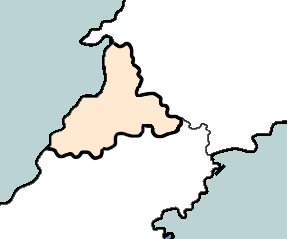Patrian People's Republic
Patrian People's Republic Patria Populi Reipublicae République Populaire Patrienne Repubblica Popolare Patrizia | |
|---|---|
| (5 years, 2 months and 4 weeks) | |
 Largest extent of Patrian People's Republic | |
| Status | Limited recognition by several sovreign nations between 1936 and 1941. |
| Capital | Sable |
| Religion | Athiest state |
| Government | Soviet democracy |
| History | |
• Established | 1936 |
| May 17, 1936 | |
• Capitulation of the Patrian Soviet at the Battle of Viersat. | August 24, 1941 |
• Disestablished | 1941 |
| Today part of | Reincorporated into Luminerra and Notreceau |
The Patrian People's Republic (Vetus Patrian: Patria Populi Reipublicae), abbreviated as PPR, was a Soviet republic formed from lands located in northern Luminerra and southern Notreceau, primarily focused around the Lumenic provinces of Pirago and Notteri, as well as the Notreceauen Department of Cœurerre. The Patrian People's Republic was formed followed popular uprising within several towns and cities within the aforementioned regions, and established by decree of the Patrian Soviet on May 17, 1936. Almost from its inception, the Patrian People's Republic straggled for existence, fighting against armed incursions from both Lumierra and Notreceau, which are collectively categorized under the wider Patrian People's Rebellion, also referred to as the Patrian People's War of Liberation. The governments of Luminerra and Notreceau did not recognize the sovereignty of the Patrian People's Republic, with most of the world following suit. The nation's sovereign existence was only recognized by the Order of Soviet Socialist Republics, and the Copperhad Republic. The OSSR lent substantial material and economic aid to the PPR during its existence.
The Patrian People's Republic ceased to function as an independent nation on August 24, 1941 following the capitulation of the Patrian Soviet following the Battle of Viersat. Following the end of hostilities and the end of the rebellion, neither Luminerra nor Notreceau were able to reach a definitive agreement on where the border between both nations would be located. This disagreement was resolved by the issuance of the 1942 Papal Aquila "Per Gradus in via Reconciliationis" by Pope Ignatius III.

